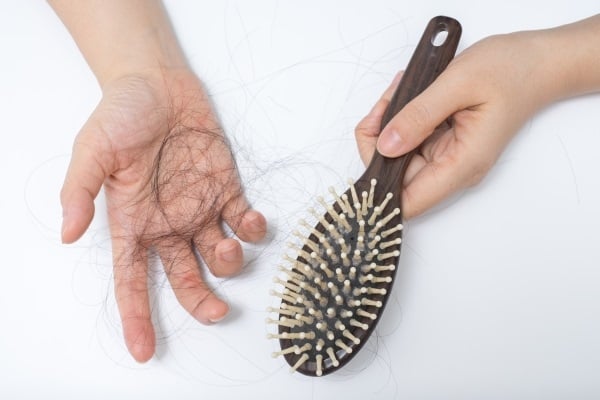Is Finasteride A Useful Treatment For Hair Loss?

Short facts about hair loss and Propecia
- Baldness or hair loss is a disturbance in the natural and cyclic process of hair growth, that affects our self-image
- There are 3 different types of hair loss: Androgenic alopecia (AGA), alopecia areata (AA) and chemotherapy-induced alopecia (CIA) that have very different pathophysiology and treatments
- The loss of large amounts of hair is causing stress and a demand for an effective alopecia treatment
- Dermatologists usually recommend combined systemic treatment with oral, topical treatment,
- Hair follicle biology, the role of stem cells and in vitro/in vivo models for drug discovery are active areas of research.
- Finasteride/Propecia was approved for the treatment of androgenetic alopecia
Click HERE to View Finasteride Prices > >
What is the main cause of hair loss?
The haired skin is composed of a pilosebaceous unit that contains a hair follicle, interfollicular epidermis and stem cells ensuring the turnover of the skin epidermis during tissue homeostasis and repair. Hair follicles are part of our skin where they produce filaments, largely composed of the protein keratin, with the function of maintaining the body’s protective barrier against its external environment. Keratins are the major structural component of the hair follicles and are generally divided into type I (acidic) and type II (neutral-basic) proteins of the hair follicles. Hair growth is a cyclic process, composed of three phases: growth (anagen), stagnation (telogen) and involution (catagen).
ANAGEN PHASE
Your hair grows, approximately around half an inch a month.
CATAGEN PHASE
The hair enters a short transitional period, in which it doesn’t grow.
TELOGEN PHASE
Means the rest period for your hair, your hair is released and falls out. The hair follicle then remains inactive for 3 months and the whole process is repeated.
Each hair follicle is independent and goes through the growth cycle at different times, thus regeneration and hair-fall remain in a natural balance. In the scalp, the average length of the anagen phase is 1000 days; the catagen phase lasts only a few days, and the telogen phase lasts 100 days.2 Nowadays, hair still has great social significance for human beings. Healthy hair indicates health, youth and vigour. It is a mark of our personality, we can dye it, we can style it, as we like. We care about the health of our hair and we definitively don’t want to lose it. But what if our hair begins to massively fall out? What can we do if we don’t want to lose it all?
Scientifically known as Androgenic alopecia or AGA, this type of hair loss is the hereditary thinning of the hair caused by androgens.3 This condition is also known as male-pattern hair loss or common baldness in men and as female-pattern hair loss in women. Thinning of the hair usually begins between the ages of 12 and 40 years in both sexes, and approximately half the population expresses this trait to some degree before the age of 50.4 By 30 years of age, approximately 30% of white males have androgenetic alopecia; by 50 years of age, 50% are affected .5 White males are four times more likely to develop androgenetic alopecia than males of African origin. Hair loss follows a well- defined pattern, as described by the Hamilton–Norwood scale5, beginning with a bitemporal recession of the frontal hairline. This is followed by diffuse thinning over the vertex (top) of the scalp, eventually leading to complete hair loss in this region. The bald patch progressively enlarges and eventually joins the receding frontal hairline. Ultimately, marginal parietal and occipital hair remains, and this might also continue to thin and be lost.
Is a magic treatment available, that can grow hair back?
Of the many treatments available for androgenetic alopecia, only two (Finasteride/Propecia and minoxidil) have been scientifically shown to be useful in the treatment of hair loss. Finasteride is a highly specific inhibitor of type 2 5a-reductase activity and is approved for the treatment of androgenetic alopecia in men.3 Propecia contains 1 mg of Finasteride and may be administered with or without meals. The recommended dose of Propecia is one tablet (1 mg) taken once daily.
Generally, daily administration for three months or more is necessary before benefit is observed. Continued use is recommended to sustain benefit, which should be re-evaluated periodically. Withdrawal of treatment, however, leads to a reversal of the growth effect within 12 months.
Propecia is not indicated for use in women.
In men with androgenetic alopecia, the balding scalp contains miniaturized hair follicles and increased amounts of 5α-dihydrotestosterone compared with a hairy scalp. Administration of Finasteride decreases scalp and serum 5α-dihydrotestosterone concentrations in these men. The
relative contributions of these reductions to the treatment effect of Finasteride have not been defined. By this mechanism, Finasteride appears to interrupt a key factor in the development of androgenetic alopecia in those patients genetically predisposed.6
Finasteride Male Pattern Hair Loss Study Group
A study group, formed by Dermatologists with the purpose of determining whether Finasteride treatment leads to clinical improvement in men with male pattern hair loss, performed a 1-year comparative study recruiting 1553 men aged 18 to 41.7 Men with male pattern hair loss received oral Finasteride 1 mg/d or placebo, and 1215 men continued in a blind extension study for a second year.
Efficacy was evaluated by scalp hair counts, patient and investigator assessments, and review of photographs by an expert panel. Finasteride treatment improved scalp hair by all evaluation techniques at 1 and 2 years. Clinically significant increases in hair count (baseline = 876 hairs), measured in a 1-inch diameter circular area (5.1 cm2) of balding vertex scalp, were observed with Finasteride treatment (107 and 138 hairs vs placebo at 1 and 2 years, respectively). Treatment with placebo resulted in progressive hair loss. Patients’ self-assessment demonstrated that finasteride treatment slowed hair loss, increased hair growth, and improved appearance of hair. Adverse effects were minimal.
The Ten -years Safety Profile of Propecia
The 2011 study published by a research team led by Dr Alfredo Rossi, is the first comprehensive investigation on long-term safety and efficacy of Propecia. In “Finasteride, 1 mg daily administration on male androgenetic alopecia in different age groups: 10-year follow-up,” the Italian research team sought to fill a gap in our understanding of the long-term effects of treating hair loss with Propecia.
The study enrolled 118 men between the ages of 20 and 61, with mild to moderate hair loss, who were treated with 1mg Finasteride, with the objective of measuring hair grow. These patients were evaluated before treatment and then again at 1, 2, 5, and 10 years on treatment. The panel of Dermatologists underlined that not only that Propecia is efficient and safe for use, but there were some other interesting findings as well. Only 14% patients experienced a worsening of hair loss, while 86% benefited from the treatment over this extended time period and efficacy of the drug was found not to reduce over time for the majority of patients.
One of the most interesting findings is that patients who had hair growth in their first year of treatment are more likely than others to have better hair growth after 5 years. About half of patients experienced good hair growth in their first year, and about 53% of those patients went on to see improved growth over time. However, of the group with unchanged or worse results in their first year, only 25% saw improved hair growth after 5 years. After 10 years, almost 69% of patients who experienced growth in their first-year experienced continued growth. Only 32% of those who saw unchanged or worse results after their first year had growth at 10 years.
The physicians concluded that a patient’s response to Finasteride in the first year is a pretty good indicator of how effective long-term treatment will be for the patient. The better growth he experiences in his first year, the more likely he will have continued growth beyond 5 years of treatment. Among other findings, the age of a patient did have a statistically significant effect on the outcome, as patients older than 30 years had better hair growth in the long term. On the topic of side effects, 7 subjects (5.9%) experienced them, and some of those patients remained in the study because of what they perceived as the benefits of the treatment.
Are there side effects reported?
Several clinical trials for Propecia evidenced clinical adverse experiences. These were reported as possibly, probably or definitely drug-related: decreased libido, erectile dysfunction, ejaculation disorder and sexual adverse experiences. The following adverse reactions have been identified post-approval of Propecia. They are reported voluntarily from a population of uncertain size and it is not always possible to reliably estimate their frequency or establish a causal relationship to drug exposure:
- Hypersensitivity Reaction: hypersensitivity reactions such as rash, pruritus, urticaria, and angioedema (including swelling of the lips, tongue, throat, and face);
- Reproductive System: sexual dysfunction that continued after discontinuation of treatment, including erectile dysfunction, libido disorders, ejaculation disorders, and orgasm disorders; male infertility and/or poor seminal quality (normalization or improvement of seminal quality has been reported after discontinuation of finasteride); testicular pain.
- Neoplasms: male breast cancer;
- Breast disorders: breast tenderness and enlargement;
- Nervous System/Psychiatric: depression
Conclusion
Hair has great social significance for human beings. We tend to be more confident if our hair is healthy.
Propecia is a safe and effective hair loss medication, even when used long-term.
It is effective in patients older than 40 years and it is particularly beneficial for patients over 30 and who are in the early stages of hair loss.
Perhaps the most important finding is that a patient’s response to Finasteride after the first year of treatment can be an indicator of the patient’s success with the drug in the long-term.
Propecia contains 1 mg of Finasteride and is available for acquisition online with a prescription. Propecia is recommended to be administrated for an interval between 3-6 months or until the hair loss is stopped. It’s efficacy and the treatment duration must be evaluated by a physician.
Is finasteride a useful treatment for hair loss? Finasteride is a safe and effective treatment for controlling male pattern baldness with long-term daily use even in men over the age of 40 years. The satisfactory clinical results, the few side effects observed and the lack of alternative medications points to Finasteride as an effective treatment especially if taken in the early stages of Androgenetic alopecia.
If you are intending to use Propecia, and if you have questions related to its use, effectiveness or side-effects, please address directly to our pharmacy and to our doctor at phone number 01625 460 621.
Click HERE to View Finasteride Prices > >
References:
1. Cedric Blanpain- Epidermal homeostasis: a balancing act of stem cells in the skin
2. Harel S, Christiano AM. Genetics of structural hair disorders. J Invest Dermatol. 2012;132(E1): E22–E26. [PubMed
3. Alastair J.J. Wood- Treatment of hair loss
4. Hamilton JB. Male hormone stimulation is prerequisite and an incitant in common baldness
5. Hamilton JB. Patterned loss of hair in man: types and incidence. Annal NY Acad Sci 53, 708-728
6. PROPECIA® (finasteride) tablets for oral use. Full Prescribing Information
7. Kaufman KD, Olsen EA, Whiting D, Savin R, DeVillez R, Bergfeld W, Price VH, Van Neste D, Roberts JL, Hordinsky M, Shapiro J, Binkowitz B, Gormley GJ. Finasteride in the treatment of men with androgenetic alopecia. Finasteride Male Pattern Hair Loss Study Group. J Am Acad Dermatol. 1998 Oct;39(4 Pt 1):578-89.PubMed PMID: 9777765.
8. Rossi A, Cantisani C, Scarnò M, Trucchia A, Fortuna MC, Calvieri S. Finasteride, 1 mg daily administration on male androgenetic alopecia in different age groups: 10-year follow-up. Dermatol Ther 2011; Jul-Aug;24(4):455-61
Assured Pharmacy is not liable for the currency or accuracy of the information contained in this blog post. For specific information about your personal medical condition, please contact our doctors or pharmacists for advice on [email protected].


